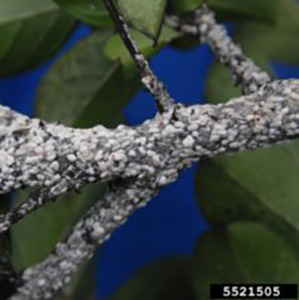Crapemyrtle bark scale, Acanthococcus lagerstroemiae (Kuwana) (Hemiptera: Sternorrhyncha: Coccoidea: Eriococcidae)
Introduction
Crapemyrtle bark scale (CMBS) is a serious invasive pest of crapemyrtles (Lagerstroemia spp.), one of the most beloved and widely planted ornamental trees and shrubs in the United States. This scale insect is native to Asia (reported in China, Korea, and Japan), and was first detected in 2004 near Dallas, Texas. It has since spread to 14 additional states: Oklahoma (2011), Louisiana (2012), Georgia (2013), Tennessee (2013), Alabama (2014), Arkansas (2014), New Mexico (2014), Virginia (2014), Mississippi (2015), North Carolina (2016), Washington (2016), Kansas (2019), South Carolina (2019), and Delaware (2020).1 Damage by CMBS has the potential to cause crapemyrtles, which are typically low-maintenance ornamentals, to require higher maintenance and pest management inputs.
As of early 2020, distribution of CMBS in South Carolina is restricted to Columbia (Richland County). It is expected, however, that additional infestations will be detected or reported in other South Carolina counties in the coming months and years since crapemyrtles are widely planted in the state. Growers, landscape care professionals, and home gardeners are encouraged to maintain vigilance and report any suspected infestation to their local extension agents. Early detection and proper treatment are critical to minimizing the spread of this invasive scale insect in South Carolina.
Description and Life Cycle
CMBS is a species of felt scale (Eriococcidae) and has a white or grayish, loosely woven, cottony wax layer (technically called “test”) over the body of an adult female or late-instar male (figure 1). This is a general characteristic of this group of scales. Under the covers, the oval adult females are both dark pink or purple. The cover of an adult female is about 2 mm long and 1 mm wide, which is four to five times the size of a late-instar male’s cover. Each female produces between 100 to 300 pink eggs under its waxy cover (figure 1).2 The crawlers (i.e. hatchlings) are tiny, pink, and the most mobile life stage. Crawlers emerge from under the covers and disperse to new feeding sites. Older nymphs generally are immobile once they settle at a suitable feeding location, but can move when disturbed. Immature females are oval and devoid of the waxy covering, exposing hairy and dark pink or purplish bodies. Late-instar males produce elongated waxy covers over their dark pink bodies, under which they continue their development. Adult males are gnat-like, fragile, and rarely seen. After emerging from their covers, adult males fly to the females, mate, and die soon after.
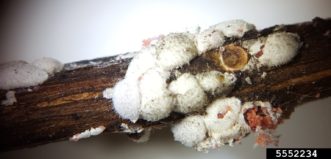
Figure 1. A population of adult female crapemyrtle bark scales on a crapemyrtle branch. Some of the white female covers were opened to expose the pink eggs hidden under the covers. Image credit: Helene Doughtry, Virginia Polytechnic Institute and State University; Bugwood.org.
Our observations of field infestation suggest that all life stages of CMBS feed on the trunks and branches of crapemyrtles (figure 2). Individual CMBS may start feeding on the branch crotches (figure 3), bud scales, wounds (figure 4, left), crevices in the branches, or under shed bark (figure 4, right). The feeding site becomes less specific as the population grows. When the infestation is severe, entire trunks or branches may appear to be covered with a layer of white or gray felt (figure 2). While the population may appear to distribute throughout the trunks, a larger number may congregate on the underside of the branches or near previously pruned areas.
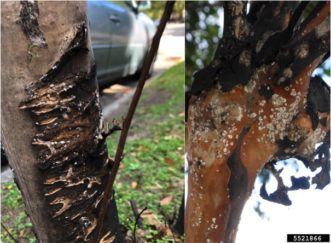
Figure 4. Crapemyrtle bark scale prefers to feed on crotches, bud scales, on wounds (left) and under shed bark (right). Image credit: David Coyle, Clemson University; Jim Robbins, University of Arkansas; Bugwood.org.
Other felt scale species, such as the azalea bark scale [Acanthococcus azalea (Comstock)] and the oak felt scale [Acanthococcus quercus (Comstock)], resemble the outward appearance and feeding habits of CMBS. These felt scales can be easily distinguished from CMBS based on their host plants. The azalea bark scale only feeds on azaleas and rhododendrons, and the oak felt scale only feeds on oaks. A felt scale species that can build a population on crapemyrtles is likely CMBS.
The life cycle of CMBS in South Carolina is unknown. Surveys conducted in Arkansas, Louisiana, and Texas reported two to four overlapping generations per year.3 Timing for crawler emergence was variable, but the first peak emergence typically occurred between mid-March and early May in these states. In the laboratory, eggs hatched within ten days at the optimum temperature of 82°F (28°C).4 A female CMBS completed development from crawler to adult in sixty-eight days at 86°F (30°C).4
The exact mode of dispersal of CMBS population is unknown. CMBS can likely disperse in several ways, similar to other scale insects and mealybugs. Long-distance or interstate dispersal through the installation of infested plant materials is the most likely mode by which the population dispersed into South Carolina. Humans can also aid in the dispersal of CMBS by transporting crawlers on their clothes, tools, and pruned plant materials. Within a site, CMBS can also be dispersed when crawlers crawl to new locations, by being blown by wind to new host trees, or by latching onto another insect or bird in a behavior known as phoresis.
Hosts
CMBS appears to have a restricted host range. While crapemyrtles are the primary hosts in the United States, other host plant species have been reported in historical records or have been confirmed through laboratory studies or field observations (table 1). The number of host plants included in the list may increase as CMBS is exposed to – and additional observations are made on – other plant species in urban landscapes.
Table 1. Confirmed and reported host plants of crapemyrtle bark scale, Acanthococcus lagerstroemiae.
| Host plant | Status | References | |
| Scientific name | Common name(s) | ||
| Anogeissus sp. | – | Reported | See 2 |
| Anogeissus latifolia | Axlewood, gum ghatti | Reported | See 2 |
| Buxus microphylla | Japanese or Korean or littleleaf boxwood | Reported | See 2 |
| Callicarpa americana | American beautyberry | Confirmed | 4 |
| Celtis sinensis | Chinese hackberry | Reported | See 2 |
| Dalbergia eremicola | Indian rosewood | Reported | See 2 |
| Diospyros kaki | Japanese persimmon | Reported | See 2 |
| Ficus carica | Common or edible fig | Reported | See 2 |
| Glochidion puberum | Needlebush | Reported | See 2 |
| Glycine max | Soybean | Reported | See 2 |
| Heimia salicifolia | Shrubby yellowcrest | Confirmed | 4 |
| Hypericum kalmianum | Kalm’s St. Johnswort | Confirmed | 5 |
| Lagerstroemia spp. (including hybrids) | Crapemyrtles | Confirmed | 4 |
| Lawsonia inermis | Henna | Confirmed | 4 |
| Ligustrum obtusifolium | Border privet | Reported | See 2 |
| Lythrum alatum | Winged loosestrife | Confirmed | 4 |
| Malus pumila | Apple | Reported | See 2 |
| Mallotus japonicus | Food wrapper plant | Reported | See 2 |
| Myrtus sp. | Myrtle | Reported | See 2 |
| Punica granatum | Pomegranate | Reported | 4, also see 2 |
| Pseudocydonia sinensis | Chinese quince | Reported | See 2 |
| Rubus sp. | Brambles | Confirmed | See 2 |
Damage
Most infestations are found in managed landscapes, such as along streets and sidewalks. It is important to scout and treat for CMBS in nurseries to avoid spreading the infestation to other areas via nursery stock. CMBS damage and symptoms are the same in landscapes and nurseries.
CMBS is a sucking insect. It removes sap from the affected trees, extracts nutrients from the sap, and excretes a sugary waste liquid called honeydew. The removal of sap and the nutrients the sap carries slowly weakens the tree. Although infestation rarely kills infested trees in the landscape, the trees can be significantly weakened. Severe infestation can sometimes kill young trees or liners in nurseries. Growth of the infested trees may be reduced, flowering delayed or reduced, defoliation may occur, and the overall appearance may become unsightly due to the presence of scale insects and the honeydew, which often turns a dark grey to black color as sooty mold grows on the sugary honeydew that coats the stems and items under the infested trees (figure 5). These damages can be reversed if the CMBS population is reduced and better care is given to the trees to help with recovery.
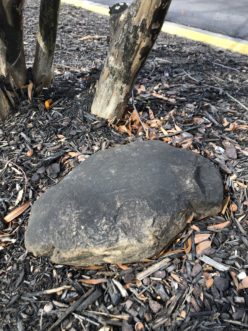
Figure 5. Trunks and items under trees infested by crapemyrtle bark scale may be covered with honeydew and sooty mold. The dark color on this rock and mulch is the result of sooty mold growing on honeydew produced by crapemyrtle bark scales. Image credit: David Coyle, Clemson University.
Management
Monitoring
CMBS is not difficult to detect or identify. The white or light gray felt covers of adult females and late-instar males are easy to see on the trunks and branches. When the infestation is heavy, branches and trunks may be covered with patches of the felt covers (figure 2), and the entire tree may be covered with shiny and sticky honeydew and black sooty mold. It is important to recognize that the presence of honeydew and sooty mold does not necessarily indicate a CMBS infestation. Crapemyrtle aphid [Tinocallis kahawaluokalani (Kirkaldy)] can also produce honeydew and sooty mold. Crapemyrtle aphid feeds on the leaves, not on the trunks or branches. Confirm a CMBS infestation by looking for the felt covers and wipe your fingers against the covers. The covers will “bleed” a bright pink liquid as you crush the live CMBS adult females and eggs with your fingers (figure 6).
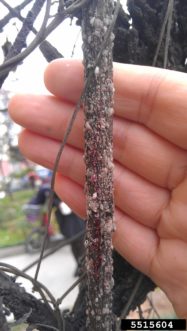
Figure 6. Branches infested by crapemyrtle bark scales will “bleed” red when fingers are rubbed over the scale populations. This can be used as a diagnostic characteristic. Image credit: Mengmeng Gu, Texas A&M AgriLife Extension Service; Bugwood.org.
Similar to many scale insect species, crawlers and young nymphs are the most vulnerable CMBS life stages and the only life stage that can move. Insecticide treatments, particularly topical sprays, should target the crawlers. Therefore, it is important to develop an effective scouting and monitoring program to detect crawler emergence and understand CMBS life cycle and population dynamics.
A degree-day model for CMBS crawler emergence is not available for South Carolina. The first peak in crawler activity in Arkansas, Louisiana, and Texas is expected to occur at 646 GDD using January 1 as the start date and 50°F base temperature.3 Another way to detect crawler emergence is to wrap an infested branch with double-sided sticky tape or black electrician tape (sticky side out) beginning in mid-April. Inspect the sticky tape weekly for tiny pink crawlers that are trapped. Insecticide sprays may begin as the number of trapped crawlers begins to increase. The sticky trap should be replaced weekly, or whenever many trapped crawlers render the trap ineffective in capturing new crawlers.
The sighting of a suspected infestation must be reported immediately to your local Clemson Extension office or Clemson University Department of Plant Industry, and do not take management action until identification has been completed. Because an expert must carefully examine an insect specimen to confirm its identity, the relevant authorities may visit your location to collect samples. You may also collect samples of multiple insects (or an infested branch) and bring them to your local Clemson Extension office for shipment to experts for identification. Your local Clemson Extension Agents can also help you contact the relevant authority.
Cultural Control
The best way to avoid CMBS infestation is to not install infested plants. Buy from a reputable producer or grower to make sure the plant materials are not infested. Always check a crapemyrtle tree carefully for the presence of CMBS before purchasing or planting.
If the infestation is light and limited to a few branches, the infested branches can be pruned out. Pruning may also open up the canopy to allow better penetration of insecticide solution or natural enemies, achieving more effective control of the scale insect population. Do not simply discard the pruned branches on-site. Always bag, remove from the site, and properly dispose of the infested, pruned materials by trashing or burning.
Nursery growers are encouraged to destroy infested plants when an infestation is detected. It may be more economical to destroy the plants than to treat them or suffer reputational damage when infested plants are sold. Similarly, the culled materials should not be left in the culled pile, but must be properly disposed of by trashing or burning.
Maintaining proper care of infested trees can allow for faster and better recovery. It may be important to limit the use of nitrogen fertilizer, especially on mature, well-established crapemyrtle trees because many sucking insects respond positively to nitrogen fertilization. Although not proven, nitrogen fertilizer may exacerbate CMBS infestations.
Although unsightly, most plants can tolerate a light amount of honeydew and sooty mold without any effect on their growth and flowering. Once the scale insect population is under control, the remaining honeydew and sooty mold will degrade and disappear in a few weeks or months. Sooty mold on hard surfaces can be removed by pressure washing or by handwashing with a solution of dish detergent and warm water. The use of soapy solution on plants may cause injury and is not encouraged.
Biological Control
Ten species of natural enemies have been identified in Texas, including six ladybeetle species and two lacewing species.2 Pupae of Hyperaspis ladybeetles are often found on CMBS-infested crapemyrtles in Columbia, indicating that ladybeetles and other natural enemies are likely present in South Carolina and may contribute to reducing the CMBS population.
No commercially reared biological control agents have been used against CMBS. Instead of releasing mass-reared biological control agents, it may be more effective and economical to conserve the natural enemies that are already present and feeding on CMBS. Conservation can be achieved by avoiding topical sprays of broad-spectrum insecticides, such as carbamates (IRAC Group 1A), organophosphates (1B), and pyrethroids (3A). These insecticides are detrimental to the survival of natural enemies, and their use may exacerbate the CMBS infestation by removing the scale insect’s natural enemies.
Insecticides
Many insecticides are registered for managing scale insects in landscapes and nurseries in South Carolina. However, not all insecticides are suitable for managing CMBS populations and damage. Several commonly used insecticides, such as carbaryl (Sevin), have been demonstrated as ineffective in trials designed to evaluate the efficacy of insecticides for CMBS management in landscapes and nurseries. Some broad-spectrum insecticides are detrimental to natural biological control of CMBS (see above). Insecticides used for CMBS management should be selected carefully. If you live and work in a state outside of South Carolina, please contact your local pesticide regulator or Extension service for a list of approved insecticides for your state. When using pesticides, always remember that the label is the law, and you must carefully follow label directions and wear proper personal protective equipment.
Insecticides may be applied as a topical/trunk spray or soil drench. Insecticides used for topical or trunk sprays are typically contact insecticides, whereas those used as a soil drench are systemic insecticides (i.e. IRAC No. 4, 23, 28). Insecticides used for trunk or topical sprays should be applied to the trunks and branches at a high enough volume to achieve thorough coverage and wetness of the plant. The waxy covers of adult females and late-instar males protect them from insecticide sprays. Therefore, insecticide sprays must be applied during or within two weeks of crawler emergence of each generation. Two applications may be required to achieve the best efficacy, with the second application applied two weeks after the first application. Adding a surfactant, such as a spreader-sticker, to the solution can improve the efficacy of topical sprays.
Systemic insecticides applied via soil drench should be applied at the time of bud break because these insecticides take time to move from the soil into the roots then to the trunks or branches. Carefully follow label instructions and calculate the appropriate amount of insecticide needed by accurately measuring the diameters of all trunks (for multi-trunk cultivars) or shrub height. Mulch should be raked away before the drench and placed back after the drench solution has completely moved into the soil. Understand that clay or heavier soil may require a longer time to soak through. Only one soil drench treatment is needed per year, and treatment can be stopped when CMBS population is completely eliminated (this may take several years).
Studies conducted in Texas and other states have reported good to excellent efficacy with a soil drench of dinotefuran (most effective) and imidacloprid, and topical sprays of bifenthrin, buprofezin, dinotefuran, and pyriproxyfen (table 2). Again, to conserve natural enemies of CMBS, we recommend avoiding using bifenthrin. Efficacy of other insecticides will be tested in different states in the coming years.
Table 2. Insecticides demonstrated to provide good to excellent reduction of crapemyrtle bark scale population in landscapes and nurseries.
| IRAC No. | Chemical class | Active ingredient | Example trade names |
| 3A | Pyrethroids | bifenthrin | Bifen, Onyx, Talstar, Up-Star |
| 4A | Neonicotinoids | dinotefuran | Safari, Zylam, Transect |
| imidacloprid | Bandit, CoreTect, Imidacloprid, Mallet, Marathon, Merit, Xytect | ||
| 4D | Flupyradifurone | flupyradifurone | Altus |
| 7C | Pyriproxyfen | pyriproxyfen | Distance IGR, Fulcrum |
| 16 | Buprofezin | buprofezin | Talus |
| 28 | Anthranilic diamides | cyantraniliprole | Mainspring |
Note: Products listed here are for information and examples only and do not constitute endorsement of the products by Clemson University. Check labels for precautions, use site, application, and rate information. IRAC = Insecticide Resistance Action Committee.
References Cited
- Early Detection and Distribution Mapping System (EDDMaps). Tifton (GA): The University of Georgia, Center for Invasive Species and Ecosystem Health; 2020 [accessed 2020 Apr 8]. https://www.eddmaps.org/cmbs/.
- Wang Z, Chen Y, Gu M, Vafaie E, Merchant M, Diaz R. Crapemyrtle bark scale: a new threat for crapemyrtles, a popular landscape plant in the U.S. Insects. 2016, Dec;7(4):78. doi: 10.3390/insects7040078.
- Vafaie E, Merchant M, Xiaoya C, Hopkins JD, Robbins JA, Chen Y, Gu M. Seasonal population patterns of a new scale pest, Acanthococcus lagerstroemiae Kuwana (Hemiptera: Sternorrhyncha: Eriococcidae), of crapemyrtle in Texas, Louisiana, and Arkansas. Journal of Environmental Horticulture. 2020 Mar;38(1):8-14.
- Wang Z, Chen Y, Diaz R. Temperature-dependent development and host range of crapemyrtle bark scale, Acanthococcus lagerstroemiae (Kuwana) (Hemiptera: Eriococcidae). Florida Entomologist. 2019 Apr;102(1):181-186.
- Schultz PB, Szalanski AL. Hypericum kalmianum (St. Johnswort) confirmed as a new host of the crapemyrtle bark scale in Virginia, USA. Journal of Agricultural and Urban Entomology. 2019 Mar;35(1):12-14.
References Consulted
- Vafaie, E., and C. Knight. Bark and systemic insecticidal control of Acanthococcus (= Eriococcus) lagerstroemia (crapemyrtle bark scale) on landscape crapemyrtles, 2016. Arthropod Management Tests. 2017 Jan;42(1):tsx130.
- Vafaie E, Merchant M, Gu M. Crapemyrtle bark scale. College Station (TX): Extension Entomology, Texas A&M AgriLife Extension Service; 2018 [accessed 2020 Feb 18. https://extensionentomology.tamu.edu/insects/crapemyrtle-bark-scale/.
- Vafaie E, Merchant ME, Heinz KM, Gilder K, Gu M, Cai X, Chen Y. Spread and management of Acanthococcus (= Eriococcus) lagerstroemiae Kuwana (Hemiptera: Eriococcidae) on crapemyrtle (Lagerstroemia spp.) in the USA. International IPM Symposium; 2018 Jan; Baltimore (MD). https://www.researchgate.net/publication/327579414_Spread_and_management_of_Acanthococcus_Eriococcus_lagerstroemiae_Kuwana_Hemiptera_Eriococcidae_on_crapemyrtle_Lagerstroemia_spp_in_the_USA [Accessed 18 February 2020]
- Vafaie E, Gu M. Insecticidal control of crapemyrtle bark scale on potted crapemyrtles. Fall 2018. Arthropod Management Tests. 2019;44(1):tsz061
- Vafaie E. Bark and systemic insecticidal control of Acanthococcus (= Eriococcus) lagerstroemia (Hemiptera: Eriococcidae) on potted crapemyrtles, 2017. Arthropod Management Tests. 2019;44(1):tsy109

